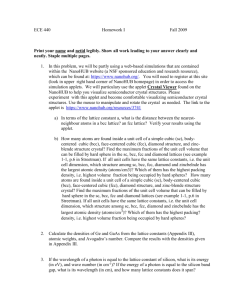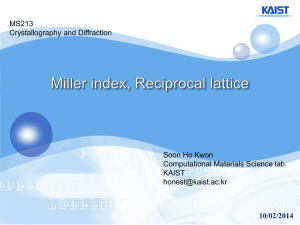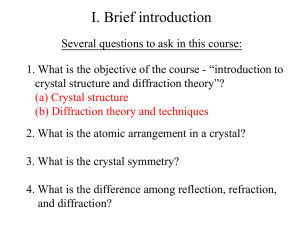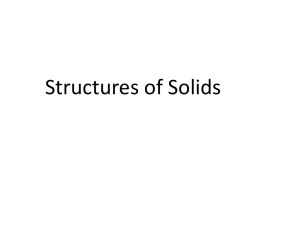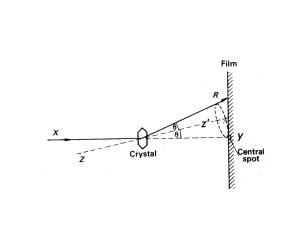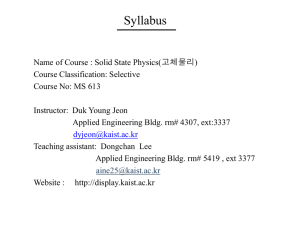a,b
advertisement
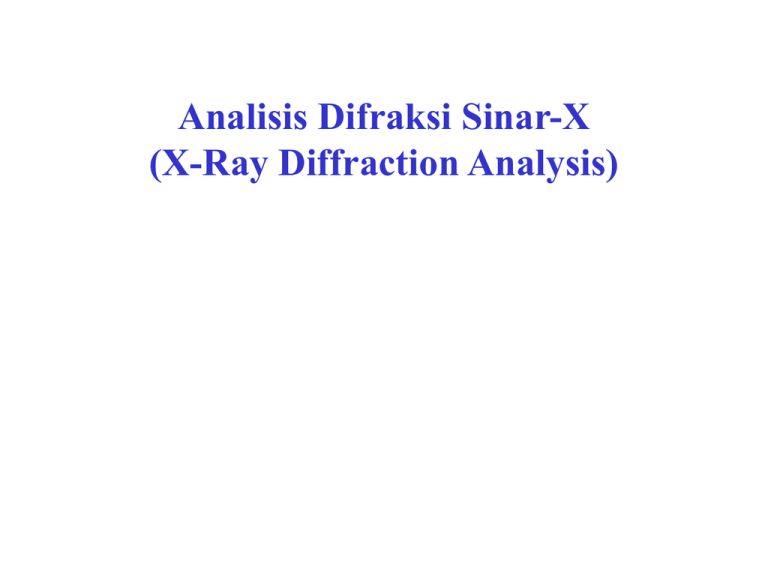
Analisis Difraksi Sinar-X
(X-Ray Diffraction Analysis)
Crystal Structure
Reading: Ashcroft 4-7
Ideal Crystal: Mengandung susunan atom/ion secara periodik
Direpresentasikan oleh titik kisi
Sekelompok atoms yang membentuk titik kisi
Basis
LATTICE = Kisi susunan titik dalam ruang yang memiliki lingkungan
identik antara satu dengan lainnya
CRYSTAL STRUCTURE = Susunan atom (kelompok atom) yang
berulang .
It can be described by associating with each lattice point a group of
atoms called the MOTIF (BASIS)
Translational
vector
{R = n1 a1 + n2 a2 + n3 a3}
UNIT CELL = The smallest component of the crystal, which when
stacked together with pure translational repetition reproduces the
whole crystal
Primitive Cell: simplest cell, contain one lattice point
Not necessary have the crystal symmetry
Conventional cell vs. Primitive Cell
Reflecting the symmetry
Different Basis
P
P
5 Kisi Bravais dalam 2D
NP
Square
a=b
=90
Rectangular
a b
=90
Centered
Rectangular
Hexagonal
a b
=90
a=b
=120
Oblique
a b
90
5 Kisi Bravais dalam 2D
Translational
vector
Definition:
3D: 14 Bravais Lattice, 7 Crystal System
Bravais Lattice: an infinite array of discrete points with an
arrangement and orientation that appears exactly the same from
whichever of the points the array is viewed.
Name
Triclinic
Monoclinic
Orthorhombic
Tetragonal
Cubic
Number of Bravais lattices
1 (P)
2 (P, C)
4 (P, F, I, A)
2 (P, I)
3 (P, F, I)
Trigonal
1 (P)
Hexagonal
1 (P)
Conditions
a1 a2 a3
a1 a2 a3
= = 90°
a1 a2 a3
= = = 90°
a1 = a2 a3
= = = 90°
a1 = a2 = a3
= = = 90°
a1 = a2 = a3
= = < 120° 90°
a1 = a2 a3
= = 90°
= 120°
Kisi FCC
Logam Cu memiliki
kisi face-centered
cubic
Atom-atom identik
terletak pada sudut
dan pada bagian
muka kisi
Jenis Kisi adalah
type F
also Ag, Au, Al, Ni...
BCC Lattice
-Fe merupakan sebuah
kisi body-centered
cubic
Atom-atom Identik
terletak pada sudut dan
body center (nothing at
face centers)
Lattice type I
Also Nb, Ta, Ba, Mo...
Simple Cubic Lattice
Caesium Chloride
(CsCl) is primitive
cubic
Different atoms at
corners and body
center. NOT body
centered, therefore.
Lattice type P
Also CuZn, CsBr, LiAg
FCC Lattices
Sodium Chloride
(NaCl) - Na is much
smaller than Cs
Face Centered Cubic
Rocksalt structure
Lattice type F
Also NaF, KBr, MgO….
Diamond Structure: two sets of FCC Lattices
Tetragonal: P, I
One 4-fold axes
Why not F tetragonal?
Example
CaC2 - has a rocksalt-like structure but with
non-spherical carbides
C
2-
C
Carbide ions are
aligned parallel to c
c > a,b
tetragonal symmetry
Orthorhombic: P, I, F, C
C
F
Another type of centering
Side centered unit cell
Notation:
A-centered if atom in bc plane
B-centered if atom in ac plane
C-centered if atom in ab
plane
Unit cell contents
Counting the number of atoms within the unit cell
Many atoms are shared between unit cells
Atoms
corner
face center
body center
edge center
lattice type
P
I
F
C
Shared Between:
8 cells
2 cells
1 cell
4 cells
Each atom counts:
1/8
1/2
1
1/4
cell contents
1
[=8 x 1/8]
2
[=(8 x 1/8) + (1 x 1)]
4
[=(8 x 1/8) + (6 x 1/2)]
2
[=(8 x 1/8) + (2 x 1/2)]
e.g. NaCl
Na at corners: (8 1/8) = 1
Cl at edge centres (12 1/4) = 3
Unit cell contents are 4(Na+Cl-)
Na at face centres (6 1/2) = 3
Cl at body centre = 1
Fractional Coordinates
(0,0,0)
(0, ½, ½)
(½, ½, 0)
(½, 0, ½)
Cs (0,0,0)
Cl (½, ½, ½)
Density Calculation
n: number of atoms/unit cell
A: atomic mass
nA
VC: volume of the unit cell
VC N A
NA: Avogadro’s number
(6.023x1023 atoms/mole)
Calculate the density of copper.
RCu =0.128nm, Crystal structure: FCC, ACu= 63.5 g/mole
VC a (2 R
3
n = 4 atoms/cell,
( 4 )( 63 . 5 )
[16
2 (1 . 28 10 ) 6 . 023 10
8
3
23
2 ) 16
3
2R
8 . 89 g / cm
3
3
]
8.94 g/cm3 in the literature
Crystallographic Directions And Planes
Lattice Directions
Individual directions: [uvw]
Symmetry-related directions: <uvw>
Miller Indices:
1. Find the intercepts on the axes in terms of the lattice
constant a, b, c
2. Take the reciprocals of these numbers, reduce to the
three integers having the same ratio
(hkl)
Set of symmetry-related planes: {hkl}
Crystal Structures [OGN 21.2]
• Body-centered cubic
(BCC)
(100)
(200)
(111)
(110)
Lattice spacing
1
d
2
hkl
h k l
2
2
a
2
2
For cubic system
Crystal Structure Analysis
X-ray diffraction
Essence of diffraction: Bragg Diffraction
Light
Interference fringes
Constructive
Destructive
Bragg’s Law
n SQ QT
d hkl sin d hkl sin
2 d hkl sin
For cubic system:
d hkl
a
h k l
2
2
2
But no all planes have the
diffraction !!!
X-Ray Diffraction
• X-ray diffraction from a crystal: Bragg’s Law
n 2 d hkl sin
d hkl
dhkl: interplanar
spacing
a
h k l
2
n: order of
diffraction peak
2
2
(hkl): Miller
indices of plane
Crystal Structures [OGN 21.2]
• Body-centered cubic
(BCC)
X-Ray Diffraction
E h hc /
Mo: 35KeV ~ 0.1-1.4A
Cu K 1.54 A
Powder diffraction
X-Ray
(200)
(211)
Phase purity.
In a mixture of compounds each crystalline phase present will contribute to
the overall powder X-ray diffraction pattern. In preparative materials
chemistry this may be used to identify the level of reaction and purity of the
product. The reaction between two solids Al2O3 and MgO to form MgAl2O4
may be monitored by powder X-ray diffraction.
•At the start of the reaction a mixture of Al2O3 and MgO will produce an Xray pattern combining those of the pure phases. As the reaction proceeds,
patterns (a) and (b), a new set of reflections corresponding to the product
MgAl2O4, emerges and grows in intensity at the expense of the reflection
from Al2O3 and MgO. On completion of the reaction the powder diffraction
pattern will be that of pure MgAl2O4.
•A materials chemist will often use PXRD to monitor the progress of a
reaction.
•The PXRD method is widely employed to identify impurities in materials
whether it be residual reactant in a product, or an undesired by-product.
•However the impurity must be crystalline.
The powder diffraction patterns and the
systematic absences of three versions of
a cubic cell. Comparison of the observed
pattern with patterns like these enables
the unit cell to be identified. The
locations of the lines give the cell
dimensions.
Observable diffraction
peaks
h k l
2
2
2
Ratio
SC: 1,2,3,4,5,6,8,9,10,11,12..
Simple
cubic
BCC: 2,4,6,8,10, 12….
FCC: 3,4,8,11,12,16,24….
d hkl
a
h k l
2
2
2
2 d sin n
Ex: An element, BCC or FCC, shows diffraction peaks at 2:
40, 58, 73, 86.8,100.4 and 114.7.
Determine:(a) Crystal structure?(b) Lattice constant?
(c) What is the element?
2theta
theta
sin
2
h k l
40
58
73
86.8
100.4
114.7
20
29
36.5
43.4
50.2
57.35
0.117
0.235
0.3538
0.4721
0.5903
0.7090
1
2
3
4
5
6
2
2
a =3.18 A, BCC, W
2
(hkl)
(110)
(200)
(211)
(220)
(310)
(222)
